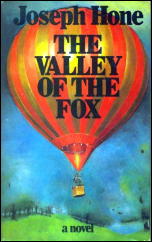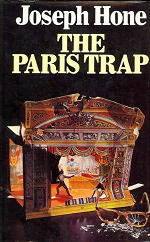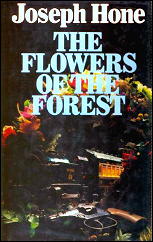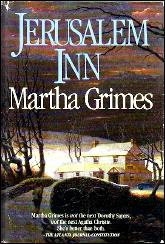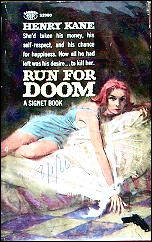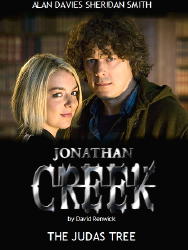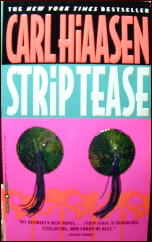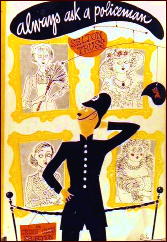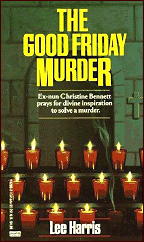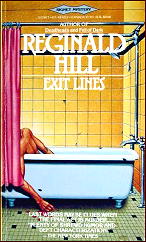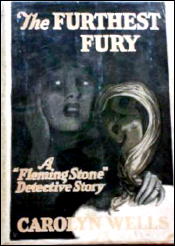Hi Steve,
A while ago I asked you about man-on-the-run novels and you and David Vineyard gave me a magnificent reply. I am still working my way through that long list of books and shall be for quite some time! In the process I have already discovered several fine authors whom I had not known of, or read, before.
I have another enquiry that perhaps you and David can help me with. As well as man-on-the-run stories I enjoy reading tales of searches for buried treasures and artefacts. This type of story seems to have made a big comeback in recent years but it’s really the older novels I’m interested in. For example, one that I read a few weeks ago was David Dodge’s Plunder of the Sun, about lost treasure in Peru. Another was Archie Roy’s Deadlight, about a search on the Scottish Island of Arran for buried scientific notes that disclose a new technology.
Of course, once found, the “treasure” can turn out to be a Pandora’s Box, releasing something malicious or vengeful or deadly, and I like these kinds of stories too.
Can you and David, and the readers of your excellent blog, suggest any more such novels?
Thank you in anticipation, — D.
And here’s David Vineyard’s reply:
Hmm, if you don’t mind I will forget anything past about 1990 so I don’t have to do too many of the Cussler and other types. Here is a quick list and perhaps it can be expanded upon by myself and others. I won’t go back so far as Rider Haggard and Stevenson, and I’ll limit myself to thrillers too.
THE THIRD HOUR by Geoffrey Household
VIVIERO LETTER and THE GOLDEN KEEL by Desmond Bagley
LEVKAS MAN, THE GOLDEN SOAK, and ISVIK by Hammond Innes
TREASURE by A.E. Hotchner
GIRL ON THE RUN by Edward S. Aarons
TROJAN GOLD and HER COUSIN JOHN and the entire Amelia Peabody series by Elizabeth Peters
THE SALZBURG CONNECTION by Helen MacInnes
BOY ON A DOLPHIN by David Divine
PLUNDER IN THE SUN, THE RED TASSEL by David Dodge
MURDER IN NEW GUINEA by John Vandercook
GRAIL by Ben Sapir
THE SECRET SCEPTRE and PRISONER OF THE PYRAMID by Francis Gerard
THE GYRTH CHALICE MYSTERY by Margery Allingham
GUARDIAN OF THE TREASURE (aka ISLAND OF TERROR) by Sapper
LIVE AND LET DIE by Ian Fleming
THE ROSE OF TIBET and THE MENNORAH MAN by Lionel Davidson
THE TREASURE OF SIERRA MADRE by B. Traven
THE LAST PLACE GOD LEFT by Jack Higgins
THE EYE OF THE TIGER and THE DIAMOND HUNTERS by Wilbur Smith
TWIST OF SAND, RIVER OF DIAMONDS and GRUE OF ICE by Geoffrey Jenkins
BRIDGE OF SAND and BROTHERS OF SILENCE by Frank Gruber
FEAR IS THE KEY by Alistair MacLean
BLACK ORCHID by Nicholas Meyer and Barry Jay Kaplan
THE Q DOCUMENT by James Robert Duncan
THE THIRTEENTH APOSTLE by Eugene Vale
PEKING MAN IS MISSING by Claire Tardashian
THE SAINT AND THE TEMPLAR TREASURE by Leslie Charteris
THE TOMB OF T’SIN by Edgar Wallace
THE GHOUL by Frank King
PRESTER JOHN by John Buchan
QUEST FOR THE SACRED SLIPPER by Sax Rohmer
THE WHITE SAVAGE by Edison Marshall
THE VENUS OF KOMPARA by John Masters
STONES OF ENCHANTMENT by Wyndham Martin (lost world novel featuring Anthony Trent)
THE SAPPHIRE by A.E.W. Mason
TREASURE FOR TREASURE by Justin Scott
TREASURE OF SAINTE-FOY by Macdonald Harris
TREASURE TRAIL by Roland Pertwee
Many of the Doc Savage novels as by Kenneth Robeson
GOLD BAIT by Walt J. Sheldon
MR. RAMOSI by Valentine Williams
GOLD IS WHERE YOU FIND IT by James B. Hendryx
BURNING DAYLIGHT by Jack London
GOLD OF ST. MATTHEW by Duff Hart-Davis
GOLD OF TROY by Robert L. Fish
GOLDEN BUDDHA by Capt. A. O. Pollard
THE GOLDEN SPANIARD by Dennis Wheatley
A DEADLY SHADE OF GOLD by John D. MacDonald
THE RAINBOW TRAIL by John Cunningham
MACKENNA’S GOLD by Will Henry
THE LAST TOMB by John Lange (Michael Crichton)
CONGO by Michael Crichton
APPOINTMENT WITH DEATH by Agatha Christie
THE TREASURE OF MATACUMBE by Robert Louis Taylor
TREASURE by Clive Cussler (and most of the Dirk Pitt novels)
THE MESSIAH STONE by Martin Caidin
THE MEDUSA STONE by Jack Du Bruhl
BLOOD ROYAL, BLIND CORNER, SHE FELL AMONG THIEVES, BERRY AND COMPANY by Dornford Yates (many of Yates novels involve some sort of treasure or loot)
THE PINK JUNGLE by Alan Williams
HIS BONES ARE CORAL and THE GOLDEN SALAMANDER by Victor Canning (both films, the former as SHARK by Sam Fuller with Burt Reynolds)
ANY OLD IRON by Anthony Burgess ( a modern family of British Jews are guardians of Excalibur)
APPOINTMENT WITH DEATH by Agatha Christie
THE GOLDEN HOARD by Philip Wylie (when the government called in gold a miser’s hoard becomes the focus of gangsters)
TREASURE OF MATACUMBE by Robert Louis Taylor
MARCHING SANDS and THE GARDEN OF EDEN by Harold Lamb (also some of his shorts from ADVENTURE about Khlit the Cossack deal with the lost treasures of Genghis Khan and the Hashishin)
THE MASK OF FU MANCHU and THE DRUMS OF FU MANCHU by Sax Rohmer
THE SANDS OF KARAKORAM by James Ramsey Ullman
THE MYSTERY OF KHUFU’S TOMB, THE NINE UNKNOWN, THE DEVIL’S GUARD, KING OF THE KHYBER RIFLES, THE IVORY TRAIL by Talbot Mundy
SPHINX by Robin Cook
THE GOLD OF MALABAR by Berkley Mather
THE NAUTICAL CHART by Arturo Perez-Reverte (a recent one, but worth reading)
THE ARROW OF GOLD by Joseph Conrad
IMPERIAL EXPRESS by James Bellah
TERENCE O’ROURKE GENTLEMAN ADVENTURER and THE POOL OF FLAME (both with Terence O’Rourke) by Louis Joseph Vance
THE SECRET OF SAREK, THE COUNTESS CAGLIOSTRO, 813, THE BLOND LADY, THE HOLLOW NEEDLE by Maurice LeBlanc (all Arsene Lupin and most dealing with his quest for the lost treasures of the Kings of France)
THE SPOTTED PANTHER by James Francis Dwyer
THE MATING OF THE BLADES (many titles) by Achmed Abdullah (NIck Romanov, a career Brit solider and the son of an Indian Princess and a Russian aristocrat, author of THE THIEF OF BAGHDAD and the screenplay for LIVES OF THE BENGAL LANCERS)
THE BLUE EYED MANDARIN by Stephen Becker
GOLD OF THE SEVEN SAINTS by Steve Frazee (western)
THE DEEP by Peter Benchley
WHITE WITCH OF THE SOUTH SEAS and ISLAND WHERE TIME STOOD STILL by Dennis Wheatley
JOURNEY TO ORASSIA by Alan Caillou
ZADOK’S TREASURE by Margot Arnold (Toby Glendower mystery)
THE FAMILY TOMB by Michael Gilbert
THE RIDDLE OF SAMPSON by Andrew Garve
THE CUP OF GOLD, THE ETRUSCAN TOMB, THE GREEK AFFAIR by Frank Gruber
THE DANCING MAN by P.M. Hubbard (one of the great thriller writers on any theme)
FIGUREHEAD by Bill Knox (a lost gold ship and a deadly feud on a Scottish island plus a possible monster — one of the Webb Carrick Fisheries Protection Service novel — yes, the Fish Police — also check out his Talos Cord series and as Noah Webster, his Jonathan Gaunt books)
THE CROWN OF COLUMBUS by Louise Edrich and Michael Dorris (good example of the literary version of the treasure hunt)
TARZAN AND THE FORBIDDEN CITY by Edgar Rice Burroughs (search for the ‘Mother of Diamonds’ also known as THE RED STAR OF TARZAN and basis for the serial THE NEW ADVENTURES OF TARZAN serialized on radio)
SEA GOLD by Ian Slater
OUT OF THE DEPTHS by Leonard Holton (Father Bredder on holiday goes scuba diving for treasure and murder)
RIPTIDE and ICE LIMIT by Douglas Preston and Lincoln Childs (okay, they are well into the later period but both outstanding)
THAI GOLD by Jason Shoonover ( not the greatest writer in the world, but interesting because the author is a treasure hunter and relic hunter in real life)
Many of Jonathan Gash’s Lovejoy books touch on treasure hunts
TEMPLE TOWER by Sapper aka H.C. McNeile (Bulldog Drummond hunts a treasure and battles a master criminal,Le Bossu, the Hunchback, in France)
THE NAME OF THE ROSE by Umberto Eco
THE CLUB DUMAS by Arturo Reverte-Perez
THE TAKERS by Jerry Ahern (UFO’s, lost Atlantis, the Antarctic — everything but the kitchen sink)
ICEBOUND by Rick Spenser (paperback original series but better written than usual, the VIKING CIPHER series)
THE ABOLITION OF DEATH by James Anderson
MYSTIC WARRIOR by Ryder Jorgenson [NOTE: See Comment #3 for the correction to this entry.]
THE POLLENBERG INHERITANCE by Evelyn Anthony
GRAVE DOUBT by Ivor Baker
THE TEMPLE TREE by David Beatty (gold-carrying plane crashes on a sacred Asian temple)
THE BUCKINGHAM PALACE CONNECTION by Ted Willis
SOLOMON’S QUEST by H. Bedford-Jones writing as Alan Hawkwood. A classic pulp adventure by the King of the Pulps one of the long running John Solomon series about cherubic Cockney businessman and adventurer Solomon — in this one he races to prevent evidence from being produced that could set the Mid-East aflame — namely that Mohammed converted to Christianity… Needless to say not politically correct. Also JOHN SOLOMON SUPER CARGO and many others.
BLACK CORAL by Nancy Ferguson
DAUGHTER OF THE HAWK by C. S. Forester. Englishwoman’s father leads a South American revolution.
THE WIND CHILL FACTOR, THE GLENDOWER LEGACY, ASSASSINI by Thomas Gifford
THE HOLLOW SEA, CLEFT OF STARS by Geoffrey Jenkins
A TASTE FOR DEATH by Peter O’Donnell. Modesty and Willie battle criminals looking for ancient treasure and using slave labor to do it.
THE LABYRINTH MAKERS by Anthony Price
TERROR KEEP by Edgar Wallace — Mr. J.G. Reeder finds love and treasure.
THE DIAMONDS OF LORETA by Ivor Drummond (Sandro, Colly, and Lady Jenny adventure)
